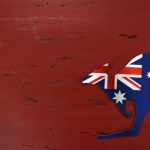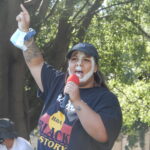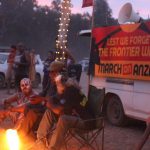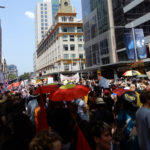March This Invasion Day: NSWALRA’s Clayton Simpson-Pitt on the Sydney Rally
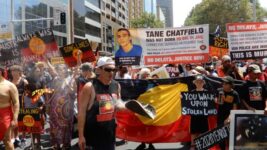
This 26th of January marks 234 years since the British ships arrived at Kamay-Botany Bay to commence a colonial project that involved genocide upon and the dispossession of the hundreds of First Nations that exist right across the continent now known as Australia.
Whilst 200-odd years can seem like a long time, in reality it’s a blink of an eye in comparison to tens of thousands of years, which means the imported systems of incarceration and law enforcement that continue to dispossess and harm First Nations people are fairly recent developments.
Aboriginal and Torres Strait Islander peoples have been living these truths over the entire period, whilst white Australia attempted to push this understanding to the back of mind, writing it out of the history books, and conveniently upholding the myths of “terra nullius” and “peaceful settlement”.
But this is changing. And it’s evidenced by the increasing numbers of First Nations and non-Indigenous peoples who turn up at Invasion Day rallies every 26th of January, which is a date that starkly represents the bloodshed, the stolen wealth and the grand theft of lands.
Half a decade strong
This year’s 26th of January is of particular significance as it marks the 50th anniversary of the Aboriginal Tent Embassy, which was established on the lawns of what is now Old Parliament House on the date that marks the invasion in 1972.
The ongoing Tent Embassy action was sparked by then Australian prime minister Billy McMahon announcing on Invasion Day eve that his government would not be recognising Aboriginal land rights, but rather it would be establishing a system of 50 year leases.
Outraged by McMahon’s proposal, Black Power activists met in Sydney following its announcement and decided to send four young men – Billy Craigie, Tony Coorie, Michael Anderson, and Bertie Williams – to set up the ongoing political protest before what was then the seat of government.
And as Ualaroi Kamilaroi Weilwan Murdi Clayton Simpson-Pitt explains, fifty years on, Aboriginal and Torres Strait Islander peoples across the continent are continuing to fight for their rights to their own lands, with the Embassy being a symbol of the resilience of this struggle.
Gadigal Country
Simpson-Pitt founded the NSW Aboriginal Land Rights Association (NSWALRA) in March last year, which “is a grassroots Aboriginal community-controlled organisation with a mandate centred around upholding the purpose of the NSW Aboriginal Land Rights Act 1983”.
The land rights advocate will be attending the Sydney Invasion Day rally 2002, which is being hosted by FISTT (Fighting in Solidarity Towards Treaties), ISJA (Indigenous Social Justice Association) Sydney and ASEN (Australian Student Environment Network).
Sydney Criminal Lawyers spoke to NSWALRA chief executive Clayton Simpson-Pitt about the need for an official truth-telling body in NSW, the legacies of the Aboriginal Tent Embassy and the work that his organisation is doing to establish land rights in this state.
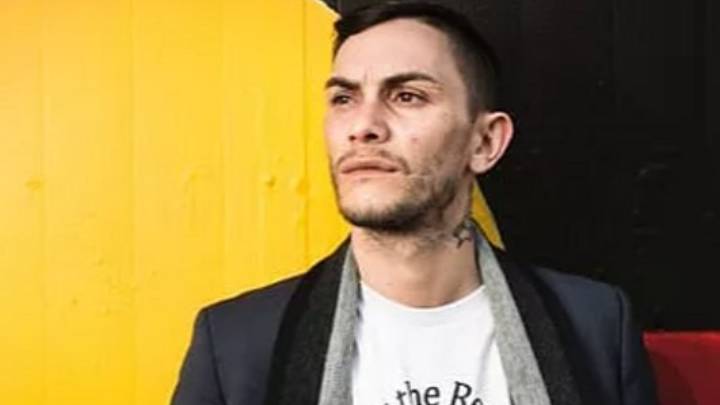
The Sydney Invasion Day rally is set to kick off this year at this city’s Town Hall on 26 January. There are similar demonstrations taking place throughout NSW and indeed across the continent.
Clayton, what would you say is the significance of these rallies?
We’ve been rallying on the 26th of January for almost 100 years. And the message is essentially still the same.
We want our land rights. We want the truth to be told in the form of a truth, reparation and treaty commission.
In 1938, we were fighting for citizenship rights. In ’72, we were fighting for land rights. In 2022, it’s no different, we still want our land rights, and we still want to be treated better.
You started your activism and advocacy a decade ago. Over that time, Invasion Day and the events and rallies around it have gained a much wider supporter base. How would you describe what’s happened?
My generation has a big part to play in that. We’re tech-savvy and media-savvy.I see it as a generational shift.
Back in the 1930s, we had a generation that fought for our rights, got out on the streets and advocated. Then we had a slowdown period.
That picked back up in the 1970s, and then we’ve had another slowdown period. And this new period is starting to pick up now.
Every second generation is part of that resurgence of Black rights, being proud of who we are and where we come from, and not accepting the crumbs that have been offered to us.
The wider Australian community agrees with us. That’s why we’re seeing more people out on the streets supporting our cause.
People want to learn the truth about their country, whether they are black, white or brindle. We can see it even in the corporate sector, not just the grassroots. We see it in the workplace as well.
These conversations are happening in the workplace. And they’re happening in parliament.
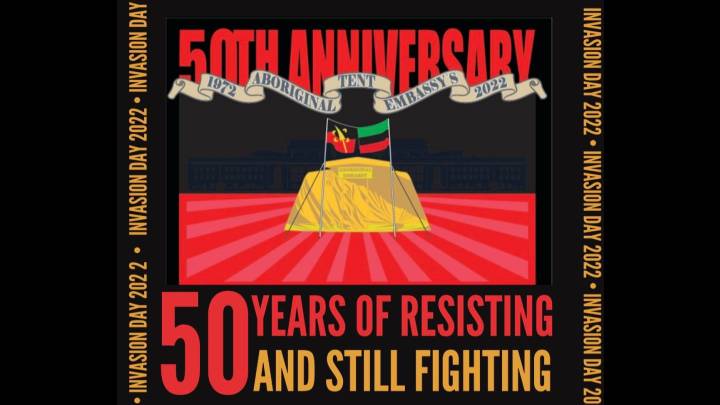
This year’s 26th of January holds a further significance as it marks the 50th anniversary of the Aboriginal Tent Embassy. What sort of role does the Embassy play?
A lot of the activism and the advocacy that came from what we now know as the Aboriginal Tent Embassy paved the way for all the legislative reforms that we see today in Aboriginal affairs.
It paved the way for the Northern Territory Land Rights Act, the NSW Aboriginal Land Rights Act, and the Jervis Bay Aboriginal land grant.
A lot of the founders that turned up in ’72 went onto establish organisations that we have today, whether that be Link-Up or the land councils, education bodies and political bodies, such as ATSIC, the National Aboriginal Conference and the NIAA.
All of these government agencies stem from the activism of the Embassy. No one wanted to have a Department of Aboriginal Affairs in 1972. No one wanted to have an Aboriginal Land Rights Act in 1972.
A lot of the organisations and reforms that we have today in Aboriginal affairs have come from the activism of the Aboriginal Tent Embassy.
Nothing was handed to us on a platter. We fought hard for it. We got locked up for it. And we got bashed for it. The Embassy is a reminder of all that.
The Embassy is a reminder of how our people live.
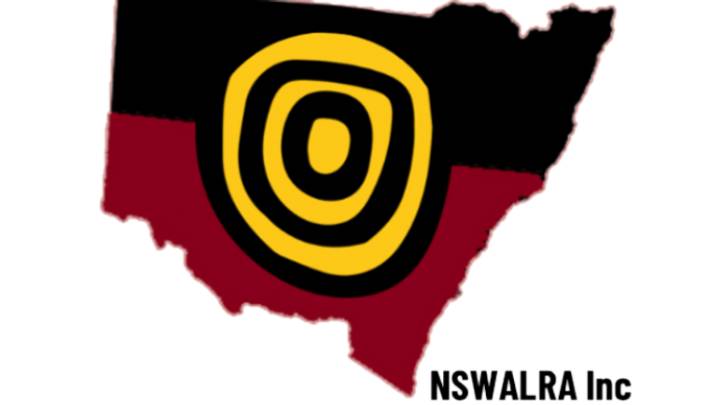
You founded the NSW Aboriginal Land Rights Association in March 2021. It’s a grassroots First Nations controlled organisation, with its chief concern being upholding the Aboriginal Land Rights Act 1983 (NSW).
Can you elaborate on what that means?
The NSW Aboriginal Land Council is a statutory body of the NSW government. It was set up to address land reform in this state for Aboriginal people, so Aboriginal people could claim back vacant Crown land.
What has happened is it takes a long time for the land claims to be processed. That’s one problem. But the major concern is that our people are still renting on our land.
We’ve got communities with tribal elders, whether they be in their 70s or 80s, living in the same home that they’ve lived in since the 1960s – over sixty years of tenancy – but they’re continuing to pay rent in the same house.
We are renters. We are not owners. And the Land Rights Act has effectively turned us into renters in perpetuity. When can we own our land? How long are we going to keep renting for?
So, that’s why I established the Aboriginal Land Rights Association, so we can help the land councils.
Land ownership can be achieved under the Aboriginal Land Rights Act. It is just the way we are interpreting it and applying it that isn’t in the original purpose it was set up for.
Section 52D of the Act allows for the transfer of property to members in good faith.
So, what I am currently working on is a new policy proposal to present to the NSW Aboriginal Land Council, which takes into account long-term renters, so we can look at how long they have been living in these houses for and strategies and policies that address that they’re renting in perpetuity.
We have never had anything given back to us from what was stolen. The Land Rights Act is a compensation scheme to give us land back.
The lands that have been provided are on flood plains or they can’t be developed. The land might be of too sacred significance for economic development.
So, the Land Rights Act has really limited economic prosperity for Aboriginal communities.
What I have done is made amendments and reviews that have been picked up by the minister for Aboriginal affairs and certain members of parliament.
I’ve been lobbying for political reform, improving policies and legislating policies aimed for Aboriginal people with regard to Land and Housing NSW.
The core part of why I founded the association is so we can address long-term renters. How long are we going to be renting these houses for? Aren’t we better off as homeowners as opposed to long-term renters?
There is no security in Aboriginal housing when someone passes away. There is no guarantee that asset will go to their next of kin or to their family. It just goes to the next person on the list.
This basically pits Aboriginal people against one another. We are fighting over crumbs. We are fighting over houses that are condemned.
We had no support over the COVID period from the government or the land councils. So, as an advocacy body, we advocated for a COVID policy that’s there for Aboriginal land councils.
What we have been able to do is partner with Aboriginal land councils and strategise for good governance, housing and COVID policies that are aligned to the law and are aligned to their members’ ways of life.
So, they’re culturally aligned to their members, to their people. And they’re aligned to the law, whether that be the Public Health Act, the Aboriginal Land Rights Act, the Residential Tenancies Act, or the Aboriginal Housing Act.
And beyond land rights, what are some other key issues concerning Aboriginal and Torres Strait Islander people that you consider should be front and centre going into 2022?
We need a truth, justice and reparations commission in NSW. What I mean by that, is a body that would complement what’s happening in other states and territories across the country.
Queensland led the path with their Path to Treaty. Tasmania has just done a letters patent for their truth and justice commission. Victoria has their Justice Commission.
NSW was the first hit. This state laid the foundation for Australia.
If we get a truth and justice commission in NSW, we will understand how the Squatters Act came about and that a lot of the generational wealth that farmers and others have today really came from the dispossession and the land grab of the 18th century.
It doesn’t even go back that far. Even in the 20th century, a lot of Aboriginal children, who would have inherited land from their white fathers, didn’t because the land wasn’t given to them because they were Aboriginal.
That happened with my family in Walgett. My great-grandfather was a white man from England. When he passed away in the 1960s, no one could get his land. My great-grandfather married my tribal grandmother from Walgett.
This brings up the question as to how we got these surnames. If we really look at it, a lot of these white farmers from the 1800s married our grandmothers because the women had lore of the land in Walgett.
So, if we go back in time, we find out how everything came about today. I’ve been reading a book from the 1780s called A Serious Admonition to the Publick on the Intended Thief-Colony in Botany Bay written by Alexander Dalrymple. He was a merchant for the British East India Company.
Dalrymple wrote this book in 1786 that basically laid the foundation for Australia. The English government went to him for advice at the time, and he told them not to go to Norfolk Island but to go straight to Botany Bay. He said, “It will be an illicit trade in the pretence of a penal colony.”
This book literally laid the foundation for Australia and what it is today. If you look at the Normandy conquest of England, it’s a very similar thing that happened here in Australia, with the colony of NSW.
So, truth and justice should be a focus this year with a truth commission here in NSW. And we also want a parliamentary inquiry into Aboriginal housing and how we can live in better quality housing.
And lastly, Clayton, for those considering attending their local Invasion Day rallies, why should they turn up? And what can be expected?
Well, they should turn up because the official Australia Day events have been cancelled, but our one is still going ahead.
So, if they want to take part in a community event, come and join us. And there will be great speakers.
Come to the Yabun festival, and understand what we do on the 26th of January. You might change the date, but we’ll still be doing this on the 26th of January every year.
And there will be thousands of people marching down George Street on the day, chanting, “Always was, always will be Aboriginal land.”




